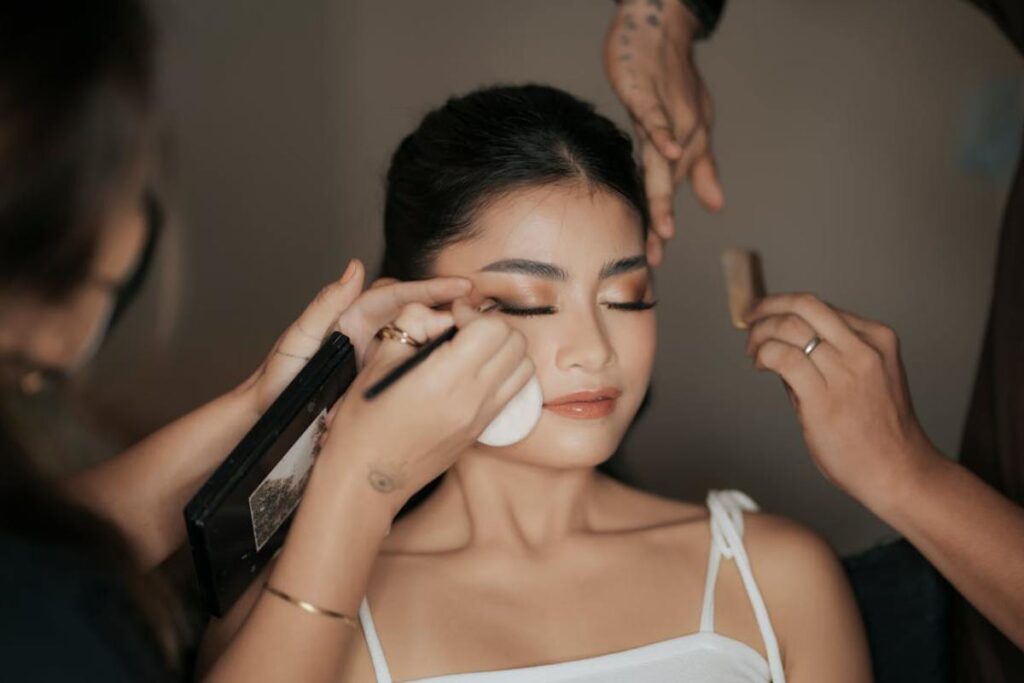If you have acne-prone skin, you know how hard it is to find the perfect foundation for it. It’s like trying to assemble a puzzle where half the pieces constantly change shape.
I’ve spent so many mornings in front of the mirror, applying concealer to new breakouts, and somehow, the foundation makes them worse. Sound familiar? You’re not alone.
One of the challenges of acne-prone skin is that foundation needs to be multi-functional. We need coverage, but we also need something that won’t irritate our skin. And honestly, sometimes, it feels impossible to find both in one bottle.
Why Your Foundation Choice Can Make or Break Your Skin
Here’s what I wish I’d heard years ago: Not all basics are created equal, especially regarding acne. Your skin is already struggling with breakouts and clogged pores, and the wrong foundation is basically adding fuel to the fire.
I remember one foundation I tried (I won’t name names, but it was expensive, and everyone raved about it). Within three days, my chin was a constellation of ugly red pimples. The foundation turned out to be full of comedogenic ingredients, which my skin hates.
What happens when you choose the wrong product:
- Your pores become even more clogged
- Existing pimples become irritated and inflamed
- You end up with that awful, flaky look
- New pimples appear seemingly overnight
But when you find the right product:
- Your skin can breathe under makeup
- Breakouts don’t always worsen (sometimes they even clear up!)
- The coverage looks natural, not like a mask
- Your self-confidence soars
Ingredients That Help Your Skin
1. Salicylic Acid: Your Pores’ Best Friend
This product is a godsend for acne-prone skin. It penetrates deep into the pores, gently breaking down pimple-causing impurities. Some foundations now contain this powerful ingredient, allowing you to wear makeup without sacrificing your skincare routine. Pretty sweet, huh?
2. Niacinamide: Inflammation Fighter
Also known as vitamin B3, this element soothes irritated skin. It helps control sebum production and reduces redness. I’ve noticed a difference with the foundations that contain it — my skin looks calmer all day.
3. Zinc Oxide: More Than Just Sun Protection
Yes, it protects against UV rays, but zinc oxide also has anti-inflammatory properties. If your skin tends to react to sure ingredients, this ingredient can soothe it.
4. Hyaluronic Acid: Hydration Without Weight
Even if your skin is oily, it still wants hydration. This ingredient provides hydration without feeling heavy or tight. This is especially important if you use acne products that dry out your skin.
Ingredients to Avoid
1.Heavy Silicones
Silicones aren’t necessarily harmful, but too much can trap oil and bacteria on your skin. If you see an ingredient list ending in “-cone,” consider looking elsewhere.
2. Pore-Clogging Oils
Coconut oil may be great for your hair, but it’s not great for acne-prone skin. The same goes for palm oil and other comedogenic oils. Stick to non-comedogenic formulas — your pores will thank you.
3. High-Alcohol Methods
These may feel refreshing initially, but they can dry out your skin and stimulate your sebaceous glands to produce more sebum. Your skin gets confused and starts producing more sebum to compensate.
Types of Foundation That Work
1. Water-Based: The Safe Choice
These are often your best bet. They’re lightweight, less likely to clog pores, and usually contain skin-loving ingredients. Fenty Beauty Pro Filt’r is a great example: it provides excellent coverage without feeling heavy.
2. Mineral Foundation: Back to Basics
There’s something so simple about mineral makeup. It’s easy to apply and often contains zinc oxide, which is great for sensitive skin. BareMinerals has been making it for years, and for good reason, it’s still popular.
3. BB Creams and Tinted Moisturisers: For Light Days
Sometimes you want full coverage without the need for a heavy foundation. These lighter options often have the benefits of SPF and skincare. IT Cosmetics’ CC+ cream is a love of skincare and makeup.
Application Hacks That Changed My Life
1. Always Start Fresh
This may seem obvious, but I often see people skip this step. Your foundation is only as good as the base underneath. Use a gentle cleanser — nothing too harsh will irritate your skin.
2. Tools Are More Important Than You Think
Damp sponges are your best friend. They give you the most natural finish and won’t scratch sensitive areas. If you prefer brushes, choose synthetic ones — they’re easier to clean and don’t harbour bacteria like natural bristles.
3. Less Is More
I used to think that more coverage equals better results. Wrong! Start thin and add more as needed. Your skin will look more natural and your pores will be less clogged.
4. Strategic Mindset
Here’s a game changer: you don’t need to powder your entire face. It is enough to powder the T-zone if it is oily. Excess powder will emphasise dry areas around pimples.
Real Results: Emma’s Foundation Transformation
Let me tell you about my friend Emma. She’s a nurse, so her foundation has to last through 12-hour shifts, but she still breaks out even with her old routine.
Her old strategy:
- Heavy silicone primer
- High coverage foundation with comedogenic ingredients
- Powder everywhere
- Constant touch-ups only made things worse
a. What we changed: We switched to a water-based foundation with niacinamide, ditched the heavy primer, and started using a setting spray instead of powder all over her face.
b. Results after one month: Emma’s breakouts have been cut in half, her foundation looks fresh even after her long transformation, and her skin texture has improved dramatically. But the most crucial change was her newfound confidence—she stopped avoiding mirrors and started retaking selfies.
My Go-To Recommendations
For Very Oily Skin
Estée Lauder Double Wear is my favourite. It stays put on everything without leaving your face feeling like cement.
For Sensitive Skin
Tarte Amazonian Clay Foundation is a clay-based foundation that absorbs excess oil while remaining gentle enough for sensitive, blemish-prone skin.
For Combination Skin
Giorgio Armani Luminous Silk strikes the perfect balance: hydrating where you need it and controlling oil where you don’t.
Budget Option
L’Oréal Infallible Pro-Matte proves you don’t have to spend a fortune to get the best results.
Mistakes I See Everyone Make
- Testing foundation on your hand – Please don’t do this. Test your jawline in natural light. Your hands are usually a different colour from your face.
- Skipping cleansing – Your skin needs natural oils to create a good base. Don’t wash everything off before applying foundation.
- Forgetting about the neck — Nothing screams “I’m wearing makeup” like a perfectly matched face on a different-coloured neck.
- Not using products for too long – Foundation can go bad and become a breeding ground for germs. If it has an unpleasant smell or has changed texture, it’s time to toss it.
- Skipping primer when needed – If you have large pores or very uneven skin, the right primer can make a massive difference in the look and longevity of your foundation.
Finding the perfect match takes time.
Here’s the untold truth: finding the best foundation for acne-prone skin is no easy task. Your skin changes with the seasons, hormones, stress levels, and age. What’s perfect now may need some tweaking six months down the line, and that’s okay.
I’ve learned to consider it an ongoing relationship, not a search for “the one.” Sometimes your skin needs more coverage, sometimes less. Sometimes it requires more hydration, sometimes it needs more oil control. The key is to stay flexible and listen to what your skin is telling you.
Don’t be afraid to ask for samples, take advantage of the return policy (seriously, Sephora’s return policy is your friend), and give each new foundation at least a week to see how your skin reacts. Some foundations that look amazing on day one may be problematic on day three.
Remember, everyone has good skin days and bad skin days. The goal isn’t perfection, but finding something that makes you feel confident and comfortable in your skin, and helps your complexion recover and improve over time.
The best foundation for acne-prone skin is one that fits your lifestyle, budget, and unique needs. Trust your instincts, be patient, and don’t let anyone make you feel bad about needing a little extra coverage while your skin heals.
Frequently Asked Questions (FAQ)
Q1: What is the best foundation for acne-prone skin?
A: The best foundation for acne-prone skin is a water-based, non-comedogenic foundation that contains beneficial ingredients like niacinamide or salicylic acid, but is free of pore-clogging oils and heavy silicones.
Q2: What benefits does the best foundation for acne-prone skin provide for those with breakouts?
A: It provides full coverage without aggravating existing breakouts, allows skin to breathe, often contains anti-inflammatory ingredients, and won’t clog pores or cause new breakouts.
Q3: What are some common mistakes to avoid when choosing a foundation for acne-prone skin?
A: Avoid using comedogenic ingredients, testing foundation on your hand instead of your face, using expired products, applying too much product at once, and choosing formulas with high alcohol content, which can irritate sensitive skin.


